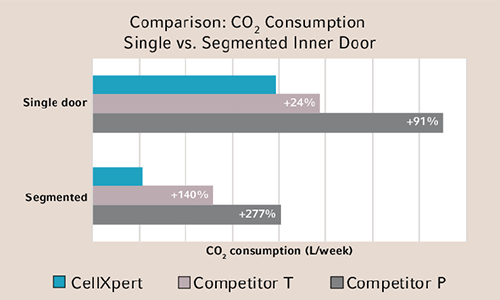How to Reduce Hidden Costs in the Cell Culture Lab
The growing economic pressure to attain greater productivity with finite resources is also a reality in modern cell culture labs, especially in biotechnology and pharmaceutical companies. Amongst many other factors, running costs for lab equipment are a significant factor when minimising overall lab expenses. Therefore, purchasing decisions must consider not only initial acquisition costs, but also the total cost of ownership over the expected lifetime of equipment. For example, running costs for a CO2 incubator can easily excel its purchase price over time and become a significant factor in total lab expenses. The following four factors and recommendations should be considered carefully before making a purchase decision for your next CO2 incubator.
Gas consumption – The underrated monster
Often underrated, gas consumption (CO2 and N2 – depending on requirements) can be a significant cost factor and easily exceed the purchase price of a CO2 incubator over its lifetime. This can be due to the costs of gas itself, but also due to the necessary employment of staff to frequently change gas cylinders. In addition to the cost factor, corporate carbon footprint reduction goals sometimes also need to be considered in this regard. Every time the door of the CO2 incubator is opened, gases escape and the atmosphere needs to be recovered after closing. The more often and the longer the door is opened in a busy lab, the more CO2 is needed (and sometimes especially costly N2 in case of cultivation under hypoxic conditions, e.g. in stem cell or cancer research).
Recommendation: Ask the manufacturer for gas consumption data, calculate the costs over the expected lifetime with your local gas prices, and consider the necessary gas cylinder change frequency and associated labour. Structural features of a CO2 incubator with low gas consumption should include smart gas supply regulation, tight seals and precise door fit (clearance). In addition, segmented inner doors are valuable means to protect the atmosphere inside the CO2 incubator and reduce disturbance of the cultured cells during door openings. Less CO2 (and occasionally N2) is needed to recover the inner atmosphere after opening and closing the small segmented door. For example, a four-segmented inner door of the CellXpert CO2 incubator from Eppendorf reduces the gas consumption to roughly 25% of an unsegmented door.

Running costs for a CO2 incubator can easily excel its purchase price over time and become a significant factor in total lab expenses.
Vessel capacity vs. lab space used – Why the heating system matters
Cell culture laboratories harbour bulky equipment like biological safety cabinets, fridges and CO2 incubators. Thus, lab space is often at a premium and must be optimised to ensure productive workflows. Therefore, devices having a small footprint while providing a high usable space inside are most favourable. In this context, it is important to understand differences in heating systems of CO2 incubators and the difference between the theoretical volume (most commonly 170L) and usable volume. The difference between the theoretical volume and the usable volume mainly depends on the number and size of interior parts and the heating system used.
Generally, CO2 incubators with a direct heating technology provide the highest usable volume versus footprint ratio, as they usually only contain a racking system, shelves and a water tray. In contrast, CO2 incubators with other heating technologies sacrifice a significant amount of usable space by additional internal parts (e.g. fan, air ducts, HEPA-filters in some fan-assisted CO2 incubators) or by a chamber-in-chamber design (water or air-jacket heating system).
Recommendation: Compare the actual number of vessels you can fit into the potential next CO2 incubator. Usually, incubators with a direct heating technology provide the highest usable space vs. footprint ratio. For example, the CellXpert CO2 incubator from Eppendorf provides up to 25% more usable space compared to fan-assisted models.
Future flexibility – Read in the glass ball of your cell culture lab
Cell culture labs grow, evolve and require instruments that are flexible to support changing experimental setups. This is especially relevant when looking at the average lifetime of equipment like a CO2 incubator (15+ years), fast growing companies or ever-evolving fields of study. Here, field-upgradeability is highly beneficial to ensure the equipment can be tailored according to the current needs without the need to pay for features that are not necessary today and may not be necessary in the future.
Recommendation: Ask the manufacturer of a CO2 incubator for in-field upgrade options, e.g. changeable door handle position to adapt to different positions in the lab, O2 control (for hypoxic conditions, e.g. in stem cell or cancer research), segmented inner doors or different monitoring options to adjust to changing documentation needs.
Consumables – Just keep on changing and paying?
Do you consider the fuel consumption, consumables and costs for regular maintenance when comparing the acquisition costs for your new car? During the buying phase of new lab equipment these considerations are often neglected as future running costs are usually not part of the planned budget for this equipment. In addition to the cost factors mentioned above, consumables that must be replaced regularly can add significant costs.
For example, some fan-assisted CO2 incubators need twice yearly replacement of the internal HEPA-filter to provide an unobstructed airflow and atmosphere accuracy. These costs can easily add up to 3000 € over the average lifetime (15+ years) of the CO2 incubator. Similarly, other internal expendable parts, e.g. UV lamps or reagents like H2O2 that are used in some incubators for chamber disinfection (instead of a high-temperature cycle), also imply recurring costs for your CO2 incubator.
Recommendation: Have the manufacturer of your potential next CO2 incubator calculate the costs for consumables over the expected lifetime as they can easily add up to several thousand €.
Content provided by:



